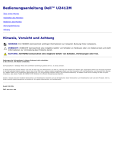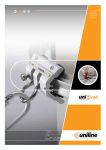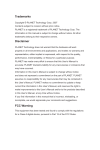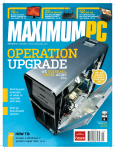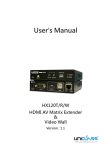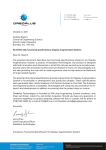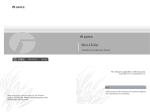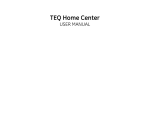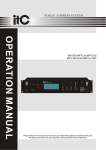Download User`s Manual
Transcript
User's Manual RD1041 Series 4-Port Quad View DVI USB KVM Switch Rev.1.1 Copyright© All rights reserved. RD1041K/RD1041Q/RD1041QD Introduction................................................................................................................ 3 Overiew........................................................................................................................ 3 Features....................................................................................................................... 3 Package contents...................................................................................................... 3 Specifications............................................................................................................. 4 Product overview...................................................................................................... 5 Front view................................................................................................................ 5 Rear view................................................................................................................. 6 KVM connection........................................................................................................ 7 Connect to console............................................................................................... 7 Connect to computers......................................................................................... 8 Daisy chain.............................................................................................................. 8 Connect to USB devices....................................................................................... 9 RS-232 control ...................................................................................................... 9 Extension (RD1041K only)................................................................................. 10 Operation................................................................................................................... 11 Push button operation............................................................................................ 11 OSD menu ............................................................................................................. 11 PC selection........................................................................................................... 12 Display mode selection...................................................................................... 12 Display mode menu............................................................................................ 13 Operation ....................................................................................................................13 Daisy chain operation...............................................................................................14 Keyboard hotkeys..................................................................................................... 15 OSD menu.................................................................................................................. 17 Operation............................................................................................................... 17 Settings................................................................................................................... 17 Information............................................................................................................ 18 RS232 Control .......................................................................................................... 19 Technical support..................................................................................................... 20 FCC / CE Statements................................................................................................ 20 2 RD1041K/RD1041Q/RD1041QD Introduction Thank you for purchasing our RD1041 series KVM switch. We recommend that you read this manual thoroughly and retain it for future reference. Overiew RD1041 (series) is a product of 4-port DVI USB KVM switch. User can easy access and control up to 4 computers with one keyboard and mouse. To monitor the computers, dual DVI monitors connection is provided. One monitor can be displayed by switching different modes (quad view, PIP view PAP view and full view) and another monitor can be displayed by full screen. Different switching modes are provided as well. User can switch to different display modes easily by pressing buttons on RD1041, selecting from OSD menu or pressing hotkey on the keyboard. The KVM signal can be extended if connecting with a KVM extender (available on RD1041K only). The KVM extender comprises 2 units, transmitter and receiver respectively. They work in pair to extend KVM signal of RD1041K up to 100m using CAT5 cable. More 100m can be extended if connecting a gigabit ethernet switch hub between transmitter and receiver. Daisy chain control is another feature of this product. With this fabulous feature, up to 32 computers (8 RD1041 connections) can be controlled by only one keyboard and mouse. More working space can be saved. In addition, with built-in USB hub function, user can access the contents of USB directly without purchasing an extra USB hub. Features ■ 4-Port Quad View DVI USB KVM ■ 1920 x 1200 resolution for clear and sharp video output ■ Support dual DVI connectors output ■ Support direct connection of 100m or 200m with gigabit ethernet switch (RD1041K only) ■ Support RS232 serial control ■ Intuitive mode selection by Hotkey, OSD, or front panel Push Buttons ■ Sturdy metal rack-mountable casing designed for 1 U application Package contents ■ RD1041 unit x1 ■ Power adapter x1 (The power adapter may vary depending on models) ■ User manual x1 ■ RJ45 to DB9 female (RS232) serial cable x1 3 RD1041K/RD1041Q/RD1041QD Specifications Model RD1041Q DVI output Console keyboard and mouse connector USB 2.0 hub Console video connector Console audio connector PC keyboard and mouse connector PC video connector CAT5 port Local: 1+1 PC audio connector PC selection Supported resolution (input) Operation Temperature Storage Temperature Humidity Limits Housing Dimension RS-232 serial port Safety / Emission 4 RD1041K RD1041QD Local: 1+1 Extend: 1 Local: 1+1 2 x USB Type A female connector 2 x USB Type A female connector 2 x DVI-I female connector 1 x 3.5mm audio jack 4 x USB Type B female connector 4 x DVI-I female connector RJ-45 female connector 4 x 3.5 mm audio jack female connector Hotkey/OSD /Push button 1920 x 1200 0° ~40° C -20° ~60° C 0 ~90% RH, Non-Non-condensing Metal 438 x 200 x 44 mm 438 x 280 x 44 mm 2 x RJ-45 female conenctors CE、FCC RD1041K/RD1041Q/RD1041QD Product overview Front view 1 2 3 No. Item Description 1 2 USB2.0 port OSD menu button Connect to USB peripherals. ■ Press to enable the OSD menu. 4 5 6 ■ Same function as Enter key under OSD menu. 3 ■ To close the OSD menu, press ESC button. ■ Press to select PC. PC selection button ■ Select the main/subordinate display in PIP mode. button to enter PIP mode. Press 1/2/3/4 • To switch the main display, press the desired PC selection button lights solid. button when the button again to lights • To switch the subordinate, press blink, and then press the desired PC selection button. ■ Lights to indicate the current connected PC. ■ Flashes to indicate the USB connection may be incorrect. Please check the USB connection between PC and this unit once the button is flashing. ■ Press and hold PC selection button 1 before turning on the power. The upgrade mode will be activated after turning on the power. ■ Turn the power off. Press and hold PC selection button 3, and then turn the power to on. The output resolution will be adjusted to 1024x768 after turning on the power. ■ To setup the hotkey, press PC selection button 4 more than 5 seconds. Arrow key 4 / / / Display mode buttons Press to move the cursor under OSD menu. Press to switch the display mode directly. Lights to indicate the current display mode. ■ Full view ■ PIP view ■ Quad view ■ 5 6 PAP view Display mode menu Press to enable display mode menu on screen. Restart pin hole Insert a paperclip into the hole to restart the system. 5 RD1041K/RD1041Q/RD1041QD Rear view RD1041K 8 1 2 7 6 3 4 5 4 5 4 5 RD1041QD 6 2 1 3 RD1041Q 6 1 No. Item 1 2 3 4 Power switch Power socket Daisy Chain (Input /Output) RS-232 control (Input port) Console ports 5 PC ports 6 Reset pin hole 7 Remote IO (RD1041K only) Dip switch 8 6 2 3 Description Press to turn on or off the unit. Plug power cable into this socket。 Connect to other RD1041 up to 8 units. Connect to a computer with RJ45 to RS232 cable for command sending using HyperTerminal. (refer to page 18) Connect console's DVI monitors, audio, USB mouse and keyboard respectively refer to the icons marked on the unit ( A: primary monitor、 B: auxiliary monitor). Connect to computers. Each section comprises audio jack, DVI connector and USB type B connector. To restore the factory default settings, insert a paperclip into the hole before turning on the power. Connect to a KVM extender to extend the KVM signal up to 100m. (refer to page 10) Adjust the dip switch when connecting to a KVM extender. Note that the Dip switches on this unit and the extender must be adjusted to same positions. RD1041K/RD1041Q/RD1041QD KVM connection * The diagrams illustrated in the chapter are emaples, the actual application may vary. All illustrated accessories and monitors are not included in the package, it is for reference only. Connect to console ■ Plug the power cord to a power socket (the power cord/adapter may vary, it is depending on the models). ■ Connect to DVI monitors, 1 Primary monitor, 2 Auxiliary monitor. Connecting same resolution and specification in both monitors are strongly recommended. If two different resolution of monitors are used, please connect the monitor of higher resolution to connector B (auxiliary monitor). ■ Connect a keyboad to the USB Type A connector which a keyboard icon marked on the unit. ■ Connect a mouse to the USB Type A connector which a mouse icon marked on the unit. ■ Connect a speaker to the audio jack. 7 RD1041K/RD1041Q/RD1041QD Connect to computers ■ Connect to a DVI monitor. 1 Connect to a computer's USB type A connector. 2 Connect to a computer's audio out jack。 Daisy chain ■ Connect to the RJ45 in connector of the first unit to the RJ45 out of second unit. First unit's out to second unit's in, and so on. Total can be connected up to 8 units of RD1041. 8 RD1041K/RD1041Q/RD1041QD Connect to USB devices * Make sure the driver of USB peripheral has been installed if necessary before plugging into RD1041. To install the driver, please remove the USB peripheral first. ■ Plug USB peripherals into the USB ports of front panel. Note that the USB ports of rear panel are not available for USB hub function. RS-232 control ■ Serial control is one of the features of RD1041. User can contorl RD1041 by sending commands from a PC as well. Please connect RS232 connector to a PC, and plug the other end of RJ45 connector into RD1041. For more detailed operations, refer to page 18. ■ Please follow the table below for more pin assignment details. - 1 - 6 1-8 5 9 Signal RS232 pin number RJ45 pin number Tx Rx GND 2 3 5 5 6 7 9 RD1041K/RD1041Q/RD1041QD Extension (RD1041K only) To extend the function of KVM, connect to an extender and ethernet hub (both are not included) are required. Typically, the extender is usually comprised of two units, transmitter and receiver respectively. For more details of extension, please contact your local distributor. Front 10 Rear Front Rear 1 Connect from the unit to a Gigabit Ethernet Hub (not included) using CATx cable. 2 Connect from a Giagbit Ethernet Hub to an AV Extender (not included) using CATx cable. Note that the Dip switches of this unit and extender should be same. RD1041K/RD1041Q/RD1041QD Operation 1. Please follow the previous chapter to connect power, PC, monitors and peripherals . Press the power button to turn on this unit. 2. Turn on the connected computers, the image will be outputted to both DVI monitors. Connector A (primary monitor) is the primary monitor and connector B (auxiliary monitor) is the second monitor. Note that the connector B (auxiliary monitor) will be displayed by full view only. 3. The keyboard and mouse will be detected after turning the computers. * Some older computers with USB interface might need to manually enable the USB option in the BIOS settings before you can use any USB devices. If your USB interface does not work, please check the USB option in the BIOS. * If you see Windows 95/98/SE or Mac OS and has not yet installed a USB mouse on your comouter, there might be an error message telling you that mouse is not detected and promptingyou to decide whether to ignore the same message in the future, and yet you will find there is no mouse movement to disable this message. So it is suggested that you should install your USB mouse on your computer first before connecting to this KVM switch. ■ To switch between different computers/audio or display modes, several convenient ways are provided. Please follow the next chapter for more details. Push button operation There are several buttons on the front panel of this unit. It can be divided by 4 sections. (1) OSD menu (2) PC selection (3) Display mode (4) Display mode menu 1 2 3 4 OSD menu ■ The OSD menu will be displayed on the monitor of connector A (primary monitor) after pressing the OSD menu button or hotkey+hotkey+ O (by default, the hotkey is ScrLk ); meanwhile, the button will be lit up blue. For more details of OSD menu operation, refer to page 16. ■ Press / / or confirm . on keyboard or / / on the front panel of unit to move cursor, press to select the desired option, and then press Enter or OSD menu button to ■ To exit the OSD menu, press ESC . ■ For more definition of buttons, refer to page 5. 11 RD1041K/RD1041Q/RD1041QD PC selection ■ If binding is enabled between USB hub, audio and auxiliary switching, they will be jointly switched at the same time. By default, these bindings are enabled. ■ USB hub, audio and auxiliary can be switched separately. To setup the binding or unbinding, please refer to page 14. * Please check the connection of USB on the rear panel of this unit if the PC selection button is flashing. Display mode selection ■ Display mode can be switched by pressing push buttons on the unit directly. Note that the B will be displayed by full view only. Full view: Displays the selected PC image by full screen. PIP view: Displays the PC images by picture in picture. To switch the main display, press the desired PC selection button when the button lights solid. To switch the subordinate display, press button again to lights blink, and then press the desired PC selection button. Note that the subordinate display will be closed if main and subordinate are setup to same PC. Quad view: Display 4 PC images in one screen. The screen will be divided into quarters. PAP view: Display 4 PC images in one screen. The selected PC will be displayed on the main screen of left side. 12 RD1041K/RD1041Q/RD1041QD Display mode menu ■ Press button or hotkey+hotkey+ O (by default, the hotkey is ScrLk ) to enable the display mode menu on the screen of connect A (primary monitor). To switch between different computers or display modes, please use your mouse or keyboard directly. Full view PIP view Quad view PAP view ■ Follow the hotkeys below to switch between different display mode. F :Full view、 I :PIP view、 Q :Quad view、 A :PAP view ■ To exit the display mode menu, press ESC , button or right key of mouse。 Operation ■ In all display modes, click left button of mouse on screen to select computer and double click to enlarge the image to full screen. Full view ■ To switch between different computers under full view mode, press 01 02 03 04 number button 1-4 to select a computer. Alternatively, select a computer from on screen display mode menu using mouse cursor. ■ Double click left button of mouse to enter Quad view. PIP view 01 02 03 04 01 02 03 04 ■ The subordinate display can be positioned anywhere by using mouse cursor. ■ Select the main display by pressing number button 1-4 or from on screen selecting menu. Select the subordinate display by pressing F1-F4 button or from on screen display mode menu. ■ Double click the main or subordinate to display by full screen. Double click the full screen to return to PIP view. 13 RD1041K/RD1041Q/RD1041QD Quad view ■ To select the active port, press number button 1-4 or click on screen 01 02 03 04 using mouse cursor directly, and then the selected screen will be highlighted by red color. ■ Double click left button of mouse to switch between quad and full view. PAP view 01 02 03 04 ■ Select main display on the left side from on display mode menu, or by pressing number button 1-4. ■ To switch between main and small screen, double click the desired samll screen on the right side using mouse cursor. ■ Double click left button of mouse to switch between PAP and full view. Daisy chain operation ■ Before starting the daisy chain operation, refer to page 8 for more connection details. The virtual cursor will appear on the screen when pressing Display mode button. User can operate these units (up to 8 units) by moving the virtual cursor to different monitors directly. To exit the virtual cursor, press Display mode button again after selecting a desired display mode. Screen of first RD1041 * The virtual cursor may be lagged when switching between different RD1041. 14 Screen of second RD1041 RD1041K/RD1041Q/RD1041QD Keyboard hotkeys 1. RD1041 provides a way of fast switching by pressing hotkey sequence. The keyboard sequence consists of at least three specific keyboards. By default, the hotkey sequence is ScrLk + ScrLk +command key(s). 2. Each keystroke within a hotkey sequence should be pressed within 2 seconds. Otherwise, the hotkey sequence will not be validated. Command Hotkeys Joint-select PC and Audio port, if the binding is enabled ScrLk + ScrLk + x = 1~4 (x=number button, corresponding to the connected PC port) Enable/Disable the beep sound ScrLk + ScrLk + Toggle PIP auto scan, default is 10 seconds. ScrLk + ScrLk + * Under the PIP mode, only active ports will be scanned and the current connected port will be skipped. Enable the OSD. ScrLk + ScrLk + Next lower port ScrLk + ScrLk + (Joint-select PC, Audio, USB hub and auxiliary, if the binding is enabled) Next higher port ScrLk + ScrLk + (Joint-select PC, Audio, USB hub and auxiliary, if the binding is enabled) Previous PC port ScrLk + ScrLk + (Joint-select PC, Audio, USB hub and auxiliary, if the binding is enabled) Bind PC and USB switching ScrLk + ScrLk + Z Unbind PC and USB switching ScrLk + ScrLk + X Switch the hub to port 1 (when binding the PC and USB) ScrLk + ScrLk + F1 Switch the hub to port 2 (when binding the PC and USB) ScrLk + ScrLk + F2 Switch the hub to port 3 (when binding the PC and USB) ScrLk + ScrLk + F3 Switch the hub to port 4 (when binding the PC and USB) ScrLk + ScrLk + F4 Enable the binding of PC and audio ScrLk + ScrLk + C Disable the binding of PC and audio ScrLk + ScrLk + V Switch the audio to port1 ScrLk + ScrLk + F5 (Press ScrLk + ScrLk + V to disable the binding) Switch the audio to port2 ScrLk + ScrLk + F6 (Press ScrLk + ScrLk + V to disable the binding) Switch the audio to port3 ScrLk + ScrLk + F7 (Press ScrLk + ScrLk + V to disable the binding) Switch the audio to port4 ScrLk + ScrLk + F8 (Press ScrLk + ScrLk + V to disable the binding) 15 RD1041K/RD1041Q/RD1041QD Command Bind A (primary monitor) and monitor) switching Unbind A (primary monitor) and monitor) switching Switch the B (auxiliary B (auxiliary B (auxiliary monitor) to port1 Hotkeys ScrLk + ScrLk + Insert ScrLk + ScrLk + Delete ScrLk + ScrLk + F9 (Press ScrLk + ScrLk + Delete to disable the binding) Switch the B (auxiliary monitor) to port2 ScrLk + ScrLk + F10 (Press ScrLk + ScrLk + Delete to disable the binding) Switch the B (auxiliary monitor) to port3 ScrLk + ScrLk + F11 (Press ScrLk + ScrLk + Delete to disable the binding) Switch the B (auxiliary monitor) to port4 ScrLk + ScrLk + F12 (Press ScrLk + ScrLk + Delete to disable the binding) Enable display mode menu ScrLk + ScrLk + O Switch PIP screen ScrLk + ScrLk + W Define hotkey preceding sequence ScrLk + ScrLk + H + (Default = ScrLk + ScrLk ) y = ScrLk , CAPS , NUM LOCK , L CTRL 和 R CTRL Enable/Disable the title bar ScrLk + ScrLk + T Note that the settings of Show PC name and Show video signal on OSD menu will not be changed. Switch to Full view ScrLk + ScrLk + F + x = 1~4 (x=number button, corresponding to the connected PC port). The screen will remain the current display mode if the entered port number is no signal or alphabet. Switch to PIP view ScrLk + ScrLk + I + ScrLk + ScrLk + P + I = Main display, P = subordinate display x = 1~4 (x=number button, corresponding to the connected PC port). The screen will remain the current display mode if the entered port number is no signal or alphabet. By default, the subordinate dispaly will be set to port 2. Switch to Quad vide ScrLk + ScrLk + Q + x = 1~4 (x=number button, corresponding to the connected PC port). The frame of screen will be highlighted by red color after pressing. Disappear the highlighted after 5 seconds. Switch to PAP view ScrLk + ScrLk + A + x = 1~4 (x=number button, corresponding to the connected PC port). The screen will remain the current display mode if the entered port number is no signal or alphabet. Daisy Chain 16 ScrLk + ScrLk + K + x = 1~8 (x=number of RD1041) Note that the audio and USB functions are only available on the first unit. RD1041K/RD1041Q/RD1041QD OSD menu 1 2 3 4 5 Operation Please follow the stpes below to operate OSD menu. Enable OSD: ScrLk + ScrLk + (Space button) Exit OSD: ESC (Escape button) Move cursor: Press / / on keyboard or on front panel Edit the name of PC: To edit the name of PC, press Insert , press Enter or OSD menu button to confirm. *Only alphabets and number can be entered. Home Auxiliary 1. Audio connection, appears when a speaker is connecting to KVM. Full view: F1 2. USB hub, appears when a USB device is plugged into KVM. PIP view: F2 3. KVM Quad view: F3 4. Video signal, appears when a PC video signal is outputted to KVM. PAP view: F4 5. USB connection, appears when PC is connecting to KVM using USB cable. Switch audio source: A ■ Bind the PC and audio switching if the Bind audio on OSD menu is setup to Yes. ■ Switch the the PC and audio individually if the Bind audio on OSD menu is setup to No. Switch to different hub: H ■ Bind the PC and USB hub switching if the Bind hub on OSD menu is setup to Yes. ■ Switch the the PC and USB hub individually if the Bind hub on OSD menu is setup to No. Switch between PIP screen: I Bind A and B switching: Home ■ Bind the A (primary monitor) and menu is setup to Yes. ■ Switch A (primary monitor) and menu is setup to No. B (auxiliary monitor) switching if the Bind auxiliary on OSD B (auxiliary monitor) individually if the Bind auxiliary on OSD Settings Hotkey Bind hub Bind audio Bind auxiliary OSD timeout Title bar timeout Show PC name Show video signal Next page Main menu Information Exit Scroll Yes Yes No 00 05 Yes Yes Sec Sec Output resolution Shrink control Auto scan period Language Load factory default Previous page Auto Fill 10 English Sec Main menu Information Exit Settings Navigate Change Settings Navigate Change 17 RD1041K/RD1041Q/RD1041QD Press or / / on keyboard or / on the front panel of unit to move cursor, press / to select the desired option, and then press Enter or OSD menu button to confirm. Item Options Description Hotkey ScrLk , , , L CTRL , R CTRL Select the hotkey preceding sequence among 5 alternative keys. Bind hub Yes/No Bind/unbind PC and USB switching Bind audio Yes/No Bind/unbind PC and audio switching Bind auxiliary Yes/No Bind/unbind OSD timeout 00/10/20/30/40/50/60 (Sec) Setup the timeout of OSD. Title bar timeout 00/05/10/15/20/25/30/Off (Sec) Setup the timeout of title bar. Note that this function is invalid if the Show PC name is disable. Show PC name Yes/No Enable/Disable the PC name display. Show video signal Yes/No Enable/Disable the current resolution display. Next page A and B switching Skip to the next page. Output resolution Auto/1920x1200/1920x1080/12 Setup the resolution of screen. 80x1024/1024x768/1680x1050 It is suggested to select the resolution based on 1600x1200 1280x720 the native resolution of connected monitor. The screen may have a blurry appearance if the monitor resolution is low than PC output. In addition, the screen may go black if selecting the resolution higher than the native resolution of connected monitor. If it happens, turn the power off, and then Press and hold PC selection button 3. Turn the power to on again. The output resolution will be adjusted to 1024x768. To check the native resolution of connected monitor, refer to the Information > Preferred timing. Shrink control Fill/Keep ratio Select Fill to fill the entire screen. The screen may be distorted or stretched. Select Keep ratio to remain the original aspect ratios. The black bars may appear on top-bottom or leftright sides of screen. Auto scan period 10/20/30/40/50/60 (Sec) Select a period of auto-scan. Language Select a preferred OSD language. Load factory default Restore the system to factory default。 Previous page Return to the previous page. Information Press / on keyboard or / on the front panel of unit to move cursor, press / or / to select the desired option, and then press Enter or OSD menu button to confirm. 18 Item Description Read monitor Re-load the monitor. Upgrade firmware Update the firmware. To update the firmware, please contact with your local distributor. Monitor model Display the name of connected monitor. Preferred timing Display the best resolution of connected monitor Firmware version Display the current version of firmware. Read monitor Upgrade firmware Monitor model Preferred timing Firmware version DELL U2412M 1920x1200 130712-130709 Main menu Information Exit Information Navigate RD1041K/RD1041Q/RD1041QD RS232 Control 1. Connect the RD1041 to a PC refer to page 9. 2. Device Manager > Ports > Communication Port, right click of mouse to open the pop-up windows, and then select Properties. (The COM port is the port which RD1041K connected) 5. Follow the point 2 to enter the data. Click Port Settings and then enter the following date. Bits per second:115200 Date bits:8 Parity:None Stop bits:1 Flow control:None 3. Open Hyper Terminal and create a new connection. Program > Accessories > Communications > Hyper Terminal 6. The Hyper Terminal will appear after completing the settings. To enter commands, press Enter . 7. For more command details, enter "help". 4. Select Connect using to COM+X (X is the port which connected to RD1041K). 19 Technical support Please contact with your local distributor for more information or technical support. FCC / CE Statements FCC Statement : This equipment has been tested and found to comply with the regulations for a Class B digital device, pursuant to Part 15 of the FCC Rules. These limits are designed to provide reasonable protection against harmful interference when the equipment is operated in a commercial environment. This equipment generates, uses, and can radiate radio frequency energy and, if not installed and used in accordance with this User Guide, may cause harmful interference to radio communications. Operation of this equipment in a residential area is likely to cause harmful interference in which case, the user will be required to correct the interference at his/her own expense. CE Statement : This is a Class B product in a domestic environment, this product may cause radio interference, in which case the user may be required to take adequate measures. RoHS Compliant http://www.uniclass.com.tw/





















